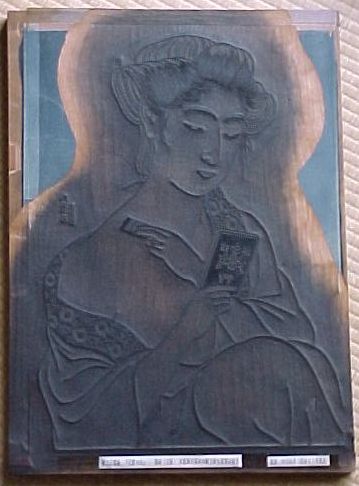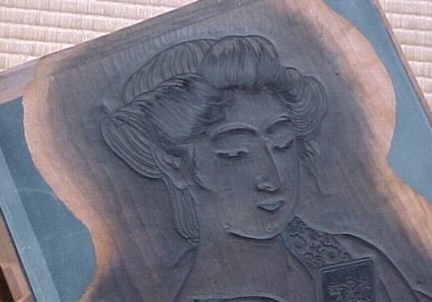Woodblock Dreams (part 2) ...
Did you enjoy the story about the woodblock in the last issue of this newsletter? At the end of it I said "... how it could have happened." So was it a dream? No, it was true. The events took place just as I described them in the previous issue.
* * *
When I had first visited him nearly twenty years ago, the present owner of that publishing company had been particularly friendly to me. At that time, I knew almost nothing about woodblock printmaking; I had seen a few prints and had made a couple of crude experiments of my own, but knew nothing at all of the real craft. That visit had been made with the intention of purchasing a set of prints that he had published, but it ended up being more than that. When he heard of my interest in becoming a traditional woodblock print craftsman, he neither scoffed at such an idea, nor discouraged me in any way. On the contrary, he gave me advice on where I could obtain tools and supplies, and even allowed me to take some blank woodblocks from his stock. In recent years, since my own woodblock publishing venture has been under way, he has always been ready to offer advice or information whenever I ask. It was on one such visit last year to get some advice on the preparation of the hanshita (the tracing that guides the carver), that I first learned about 'the block'.
On this visit, as always, he was open and willing to talk about his methods. He explained to me the different techniques of hanshita preparation that his company used, and pulled out many blocks and prints to illustrate his points. The conversation moved on from simple hanshita preparation to carving in general, and then at one point, in response to something I had asked, he went to a nearby shelf and returned carrying an old woodblock in his hands. It was quite a large block, and when he passed it across for my inspection I recognized the picture instantly - the well known 'Kessho no Onna' by Hashiguchi Goyo. (This company is known for the quality of their reproductions of Goyo's print designs).

And then, as my eyes focused properly and I looked closely at the block, I realized just what I was seeing - not only was this a beautifully carved block for a beautiful design, not only was this block obviously carved in a very special way, with every square inch of the exposed wood surface beautifully shaved off to a smooth surface, but this block was almost completely unused! A faint film of sumi ink was on the surface, showing that a few proof sheets had been printed from it, but each and every one of the delicate lines still had the crisp and razor sharp edges that show that it had never been used for production printing.
He explained something about the history of the block, but I heard almost nothing of what he said; I was simply too stunned by what I was seeing. Never, never could I have ever imagined that I would be able to see something like this. We all know that time machines are impossible - and what other possible way could there be to visit a carver's workshop of the past and see this kind of freshly carved block? No, what I was seeing was absolutely impossible.
And yet here it was, in my own hands. I tried desperately to drink in as much as I could - what angle he had held the knife at when carving those eyelashes, how deeply he had cut when carving that bold kimono line ... there was so much to learn from this block, and so little time!
Of course after a minute or two I had to put it back down on the table, and our discussion moved on ... When our conversation was over, a couple of hours later, and we started to clean up all the prints and blocks from the table, I asked if I could hold this block for a few more minutes. Again I tried to force into my memory as much as I could of what I was seeing. But a few minutes later, he had finished clearing away all the other materials and I reluctantly, but with many 'thank yous', returned the block to his hands and watched him slide it back into place on a high shelf. We then left for lunch together ... and with some resolution, I did not look back as we left the room ...
That evening back at home I couldn't shake away the memory of what I had seen. I toyed with the idea of asking him to let me try making a set of colour blocks to accompany this key block, so that an edition of the prints could be brought to life, but the more I thought about it, the more I came to realize that this block should never be used in such a way. The world has many such prints, and many such 'used' blocks, but very few, if any, unused blocks like this one. No, it was better that it remain in its present condition, and that is perhaps what the original publisher had in mind when he stored it away on a shelf all those years ago ... a gift to the future, a unique chance for future woodblock carvers to see ... to study ... and to learn.
The next morning I sent a letter, thanking him for his friendship and the time he had spent with us, and including the following paragraphs:
"Seeing that astonishing woodblock for 'Kessho no Onna' leaves me with very mixed feelings. On the one hand it is of course a great incentive to encourage me to work hard and try to become that good, but it is also a bit depressing to see such incredible work ... and to realize that I will probably never be able to match it.
"Although it may seem impolite to ask this so soon after taking up so much of your time, I would like to make another request. I want to try to pass on to other people some of the things I felt when I saw that block, so I wish to write a story about it for an upcoming issue of my newsletter. May I visit again sometime this summer and take some close-up photographs of the block?
"Of course you can guess that I am also being selfish ... I can never own such a wonderful object myself, but if I keep some large photographs of those carved lines near to my workbench I will find them a major source of inspiration ..."
I then sat down at my word processor and wrote the small 'story' you have just read on the page previous to this one. I wanted to catch as much as I could of my feelings while they were still so vivid. And of course, I dreamed about what I had seen ...
His phone call came two days later, as I sat at the carving bench working on my current print, and what he had to say was so incredible that I couldn't believe my ears. As he spoke I strained desperately to make sure that I wasn't misunderstanding his Japanese ... for surely there must be some mistake in what I was hearing. He suggested that instead of my visiting their office to take some photographs of the block ... he would send it to me so that I could study it, inspect it, and photograph it at my leisure. He wasn't giving it to me outright, but it is a measure of this man's generous character that he was willing to let it 'live' in my room for an extended period - the one place on the face of this earth where it would find the most appreciative audience, and the one place where its 'message' would be most avidly read.
* * *
The package arrived this afternoon, about three hours ago. There were some other people here when it arrived, but since they left I have been alone with the block, and it has become very quiet. Very quiet indeed ...
The block is sitting on a low table where diffused light from the windows can fall across it, and all the artificial illumination is turned off. This is the way that prints should be viewed, and it is also the best way to look at a woodblock. Now there is no rush ... no panic that I will have to let go of it in a few minutes ...

Where shall I start ...? It doesn't matter. Every line of this woodblock has much to teach me. Down here in the lower left corner the designer called for the kimono lines to be carved with quite a different feeling on the omote and the ura, the front and back of each line. I can see how Nakagawa san's wrist must have turned this way and that as his blade moved along the line. Over there in that floral pattern I can see how shallowly he left the wood when he cleared away the unneeded portion; I have obviously been trying to carve too deeply in similar situations. And of course, my eyes are inexorably drawn towards the top of the block, to the hair. And for this, there are no words available to describe to you what I see. Delicate? Thin? Hair-like? All these words are totally inadequate. I can do nothing but sit with my mouth agape ... I can learn nothing from this ...
At least not yet. But now, thanks to this block, I am no longer a mountaineer plodding blindly forward, with the slopes in front shrouded in mist. Those clouds have now been torn away, and I can see clearly where I need to go, and in which direction to climb.
On my mountain, there is no summit. Unlike a real mountaineer, I will have no single moment of success to crown my long labours. But also unlike a real mountaineer, I will not have to turn around and head back down. My journey will be forever onward ... and upward.
* * *
There isn't much more to the story. My carving skills are only very slowly developing, and when I showed my recent prints to my publisher friend at his office that day he did not praise my work, and it is right that he should not have. But although he did not say so in words, the very fact that he is allowing me to share this treasure with him, does perhaps give me a hint that he feels there is some hope for me yet. This block is indeed an inspiration for me. I hope that one day it can come to rest in a safe home in a major institution where it will be protected from the ever-present threat that someone will try to print an edition from it, for this block truly is an irreplaceable treasure. If I had any say in the matter, it would be nominated as a National Treasure, for that is surely what it is. That I am allowed to be custodian of this incredible object is the source of deep feelings of wonder and satisfaction. To this man I can only say "I have no words available to express my gratitude for your trust and friendship. Perhaps one day I can produce some prints that will make you feel that your gesture was worthwhile."
* * *
Over in my Encyclopedia pages, there is a gallery of
photographs of 'The Block'